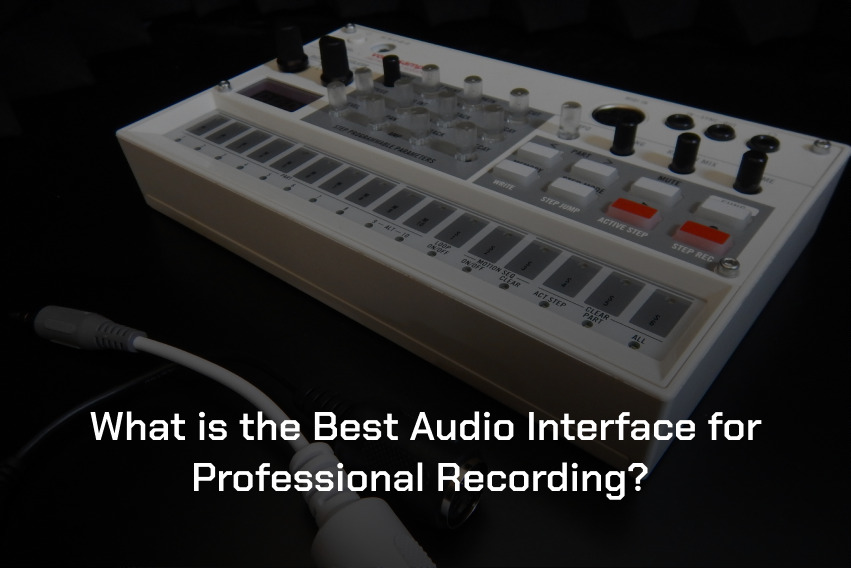Selecting the top audio interface for professional recording hinges on user needs. Solo artists may need only a single input, while others require more. The market offers vast options, challenging shoppers to find their match.
For novices, expert buying advice proves valuable in making an informed decision. Seasoned producers might skip ahead with reviews of premier selections curated over the years by industry veterans with experience in testing countless interfaces and editing leading music publications; these insights serve as a reliable guide through the myriad choices available.
Portable options for musicians
For solo musicians tapping into the digital realm with soft synths and samples, simplicity reigns. A lone input suffices; a sea of interfaces floods today’s market, though. Sifting through to snag that best match means knowledge is key—a peek at our tailored advice section could lift any beginner’s know-how notably.
As for seasoned pros, dive right in—the choices we spotlight awaiting scrutiny. Detailed assessments guide you, plus a handy pricing tool ensures value finds its way to your studio setup. Take note: Universal Audio Apollo Twin X stands out—not just muscle but mobility too defines this gem.
Whether opting for Duo or Quad depends on one’s fervor for DSP chips, with either picking promising potent enhancements to home recording escapades. Audient iD4 MkII delivers without draining wallets—simplicity meets sophistication here: two ins/outs, stellar preamp action coupled with nifty features like auto gain make it user-friendly while boosting quality big time. Lastly, don’t overlook PreSonus Studio 24c—an ally regardless of musical mission, providing sturdy build and virtual looping prowess sans cable chaos, all wrapped up with cherished MIDI ports ready at the rear.
Thunderbolt vs. USB Connections
Thunderbolt brings speed to audio interfaces, outdoing its USB counterpart. It presents less delay—latency, that is. For pros in the recording business, this means when you hit a key on your keyboard or strum a guitar string, the sound reaches your ears almost instantly with Thunderbolt’s help; no annoying lag.
Now, USB might suffice for casual use but falls short of professional standards due to higher latency rates. So if every millisecond matters in syncing tracks or using plug-ins smoothly during production sessions, an upgrade could be justified despite Thunderbolt’s steeper price and compatibility limits with some computers. Focusrite showcases this difference: their Thunderbolt option promises at least half the return time compared to its similar-spec’d USB model, which is vital for minimizing disruptive delays while working through mixes or adding virtual instruments to a session`s flow.
Budget-Friendly Professional Choices
When choosing an audio interface at a reasonable price, focus on the essentials. A device like Universal Audio Apollo x8p exceeds expectations with its Unison mic preamps and near-zero latency—a boon for professional sound quality without noise. Thunderbolt 3 rackmount is notable not just for clear signals but also because it allows users to plug into emulations of classic gear by Neve or API during recording sessions.
As vital as great pre-amps are robust I/O counts, ensure your selection satisfies your input and output demands. Consider extra digital inputs—such as S/PDIF—if expanding beyond basic analog connections in future projects interests you. Keep compatibility top of mind: will the interface sync with your existing computer ports?
Above all, align choices closely with financial limits while securing the core capabilities necessary for crisp, high-quality recordings in any studio setting.
High-End Audio Interface Investments
Investing in a high-end audio interface, such as the Universal Audio Apollo x4 HE or the Antelope Audio Zen Q Synergy Core, means getting superior sound. These units have advanced preamps and converters that shape the signal with clarity. The ProRec team confirmed after rigorous A/B testing that these interfaces do indeed deliver unparalleled audio quality.
Higher-priced models come not just with better physical components but also invest heavily in research and development (RandD). This results in lower noise floors, improved connections, and reduced harmonic distortion—attributes often lacking in budget-friendly options. The onboard digital signal processing (DSP) is particularly valuable for streamlining work processes; this comes along with virtual mixers, which shift how users handle mixing tasks altogether.
Such features are absent from more affordable selections but can be pivotal for professionals needing efficient workflows. High-quality I/O configurations add to their worth alongside ADAT/SPDIF expansion capabilities and proprietary plugins for hardware emulation—all aimed at enhancing recording experiences. Remember, though—a premium interface won’t cover up poor gear elsewhere.
For truly professional output levels, every piece of equipment counts, including microphones, monitors, and even room acoustics, so pair wisely.
Interface Compatibility and Software
Interface compatibility in audio recording is a key factor for professionals. It dictates how well different devices, like microphones and instruments, work with the audio interface. For example, the Focusrite Scarlett 2i2 connects seamlessly to most setups; it’s ideal for producers due to its ease of use and sound quality.
Software bundles add value too. They can impact an interface choice significantly—take Universal Audio Volt 276, which comes packed with music production tools suited for mixing applications. Every user has unique requirements, whether they’re vocalists using Shure MVX2U9 or bands preferring Apogee Symphony10’s expansive inputs.
Essential gear such as studio monitors pairs up based on the output specs of interfaces like the Behringer U-Phoria UMC18208, favored by drummers. Hence, while shopping around, consider what software comes along, but focus primarily on fitting your specific needs into the port choices and technical capabilities of each unit you evaluate.
User reviews and recommendations
In the realm of recording, user reviews shape a product’s reputation. Universal Audio Apollo Twin MKII garners attention for its superior preamps, a critical component for clear sound capture. Yet some users flag concerns over costly plugins, and occasional complaints emerge from various forums.
This feedback is pivotal; it paints a real-world performance picture that specifications alone cannot show. Professional reviewers often tout this interface as top-tier under $1,000; however, consumers report mixed experiences, with additional costs being a common theme in discussions online. Engineers and producers weigh firsthand accounts deeply before making purchase decisions.
They need an audio interface that proves itself in action, not just on paper, where every nuance counts.
Read also: The Evolution of Rap Beats: Exploring the Different Types
Best Interfaces for Studios
In studio gear, the Focusrite Scarlett 2i2 stands out for its ease and value. Built sturdy to stay on desks, it’s well-loved in home studios. It’s clear LED indicators are key to setting levels.
Yet this USB-friendly unit falls short with iOS gadgets; no MIDI too—those wanting old-school synths need more. For extra power to headphones and MIDI needs, turn on Universal Audio Volt 2. Yes, iPhones work with it!
But here’s a trade: It sports tiny meters and layout quirks when compared to our top choice. Serious music makers might eye Universal Audio Volt 276 next, which has a higher cost but brings pro touches like an onboard compressor easing toward that polished sound you’re after. Clear is this fact from my tests—ease wins over sheer audio prowess in these devices’ race.
Defining Your Recording Needs
When picking the best audio interface, one must weigh key features. A good start is assessing the preamps within the device as they shape your recording’s sound quality—poorly designed ones will hurt it. Make sure these can boost signals from various mics effectively.
Compatibility with computers is vital too; ensure connections like USB-C and Thunderbolt match your gear for smooth integration and fast data transfers. Inputs are another focal point: count how many you need for mics and instruments to avoid surprises during sessions. Lastly, check that phantom power is provided if using condenser microphones—it’s a non-negotiable for their full functionality.
Each choice directly affects how well you capture sounds in your unique setup.
Top Audio Interface Features
Professional audio interfaces transform recordings. Take the Universal Audio Apollo Twin X DUO, a top pick for pros. It brings high-quality sound with its Unison preamps, known to emulate vintage equipment accurately. Many in the music field trust this technology; it’s that impressive.
Another great choice is Focusrite’s SCARLETT 2I2 3rd Gen, praised for value and performance. Its crisp audio output suits various recording needs without breaking the bank.
For those on a tighter budget, Behringer’s U-Phoria UMC202HD does not disappoint either; reliable quality at an accessible price point makes it stand out.
Portability matters, too: Apogee Jam Plus delivers here—it’s compact yet robust enough for travel use due to its enduring build and USB power feature.
Selecting the best audio interface for professional recording hinges on specific needs. Studios may lean toward interfaces with multiple inputs and top-tier preamps, while solo artists can opt for compact models featuring pristine A/D conversions. Renowned brands offer reliability, yet emerging companies might present innovative features at a competitive price point.
Pros call for low latency and high-resolution support; JBZ beats understand these essentials, providing resources that ensure crisp recordings essential in producing quality tracks seamlessly integrated within modern production workflows.



